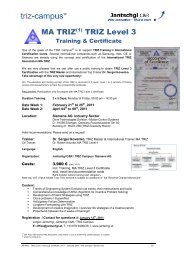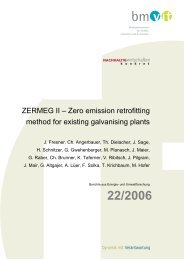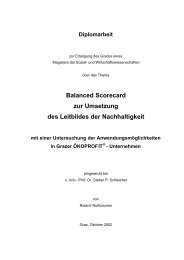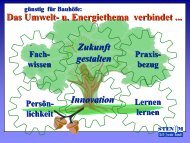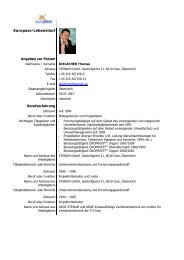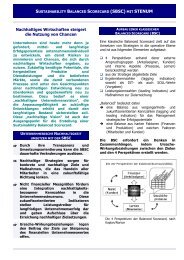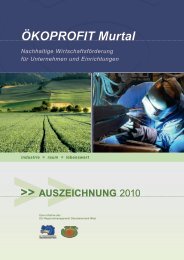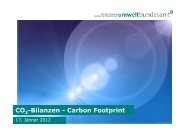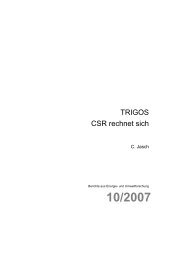Promoting Resource Efficiency in Small & Medium size ... - UNEP
Promoting Resource Efficiency in Small & Medium size ... - UNEP
Promoting Resource Efficiency in Small & Medium size ... - UNEP
Create successful ePaper yourself
Turn your PDF publications into a flip-book with our unique Google optimized e-Paper software.
Table 60 shows r<strong>in</strong>s<strong>in</strong>g criteria for the design of r<strong>in</strong>s<strong>in</strong>g systems <strong>in</strong><br />
galvanis<strong>in</strong>g. The r<strong>in</strong>s<strong>in</strong>g criterion is the dilution factor def<strong>in</strong>ed by<br />
the concentration of the substance to be diluted <strong>in</strong> the adher<strong>in</strong>g film<br />
when tak<strong>in</strong>g the part out of the active bath divided by the desired f<strong>in</strong>al<br />
concentration after r<strong>in</strong>s<strong>in</strong>g.<br />
Degreas<strong>in</strong>g 35-100<br />
Pickl<strong>in</strong>g 100-200<br />
Anodis<strong>in</strong>g 2000-4000<br />
Copper 1000<br />
Phosphatis<strong>in</strong>g 2000<br />
Nickel 3000-5000<br />
Chrome 10000+<br />
Table 60: R<strong>in</strong>s<strong>in</strong>g criteria <strong>in</strong> galvanis<strong>in</strong>g<br />
In stamp<strong>in</strong>g sheet metal, the bar between the parts should be as wide as<br />
the material is thick.<br />
Heat<strong>in</strong>g steel <strong>in</strong> a furnace typically causes high losses <strong>in</strong> oil or gas fired<br />
furnaces to the exhaust gas. The heat consumption of a typical furnace<br />
is about 3000 kJ/kg. Heat recovery to preheat the combustion air and<br />
improved control can reduce this by 30%. Induction heat<strong>in</strong>g reduces<br />
energy requirement further to less than 2000, supra-conductive coils for<br />
<strong>in</strong>duction heat<strong>in</strong>g to almost 1000 kJ/kg.<br />
9.9 Kitchen, office, sanitary use<br />
Table 61 and Table 62 show typical water consumption for kitchen<br />
operations and toilets.<br />
Equipment<br />
Commercial<br />
dishwashers<br />
Pre-r<strong>in</strong>se<br />
spray valves<br />
Commercial<br />
steam<br />
cookers<br />
100<br />
Type<br />
Water use<br />
Traditional Exist<strong>in</strong>g standard High efficiency<br />
Sav<strong>in</strong>gs potential<br />
Comments<br />
Under counter 1 – 1.8 gal/rack no standard 1 gal/rack up to 0.8 gal/rack Mach<strong>in</strong>es with an overall<br />
height of less than 36“; rack<br />
of dishes rema<strong>in</strong>s stationary<br />
with<strong>in</strong> mach<strong>in</strong>e dur<strong>in</strong>g<br />
sequential wash and r<strong>in</strong>se<br />
sprays. High temp mach<strong>in</strong>es<br />
are most water efficient.<br />
Stationary s<strong>in</strong>gle<br />
tank door<br />
S<strong>in</strong>gle tank<br />
conveyor<br />
Multi tank<br />
conveyor<br />
Handheld hosemounted<br />
dish<br />
sprayers<br />
Compartment<br />
steamers<br />
Table 61: Benchmarks for dishwasher<br />
1.1 – 2.2 gal/rack no standard 0.95 gal/rack up to 1.2 gal/rack Includes mach<strong>in</strong>es commonly<br />
referred to as pot, pan and<br />
utensil washer. Also applies<br />
to mach<strong>in</strong>es <strong>in</strong> which the rack<br />
revolves on an axis dur<strong>in</strong>g the<br />
wash and r<strong>in</strong>se cycles. High<br />
temp mach<strong>in</strong>es are most water<br />
efficient.<br />
0.7 – 1.4 gal/rack no standard 0.7 gal/rack up to 7 gal/rack A s<strong>in</strong>gle tank conveyor<br />
mach<strong>in</strong>e has a tank for wash<br />
water followed by a f<strong>in</strong>al<br />
sanitis<strong>in</strong>g r<strong>in</strong>se and does not<br />
have a pumped r<strong>in</strong>se tank.<br />
0.54 – 1.2 gal/rack no standard 0.54 gal/rack up to 0.58 gal/rack Mach<strong>in</strong>es with one or more<br />
tanks for wash water and one<br />
or more tanks for pumped<br />
r<strong>in</strong>se water. Followed by a f<strong>in</strong>al<br />
sanitis<strong>in</strong>g r<strong>in</strong>se.<br />
2 – 5 gpm 1.6 gpm at 60 psi 0.4 – 3.4 gpm<br />
25 – 35 gal/hr no standard ENERGY STAR<br />
qualified cookers<br />
average 2 gal/hr<br />
up to 33 gal/hr



